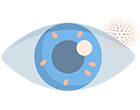Congenital Cataract Precision Panel
A cataract is a loss of lens transparency. The crystalline lens plays a crucial role in the refractive vision by facilitating variable fine focusing of light onto the retina. Congenital cataracts are usually diagnosed at birth, failure to do so can result in permanent vision loss.





